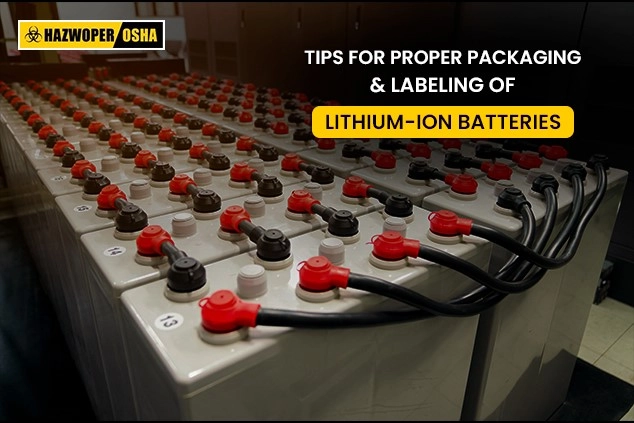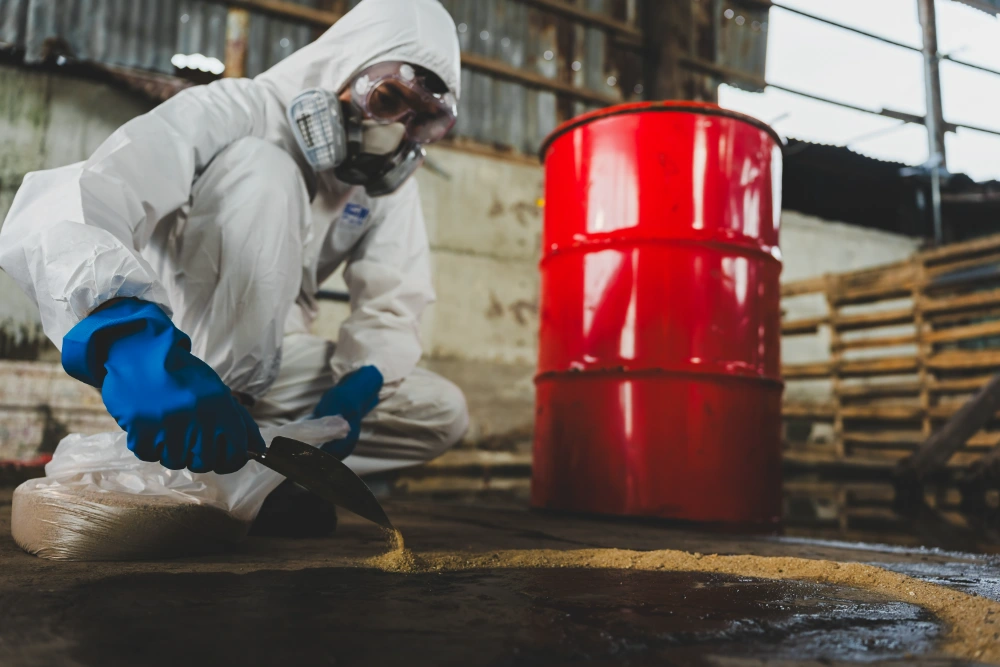Tips For Proper Packaging and Labeling of Lithium-Ion Batteries

Introduction:
From laptops to electric vehicles to massive grid storage systems, lithium-ion batteries are almost everywhere. This is when the need to ship lithium-ion batteries safely also grows. Shipping lithium-ion batteries requires proper packaging and labeling that must be according to the authorities' regulations. This article will explain in depth the proper packaging and labeling tips that should be implemented while shipping lithium-ion batteries.
Issues Caused by Faulty Packaging and Labeling of Li-Ion Batteries & Cells
Without proper packaging and labeling, Lithium-ion batteries are time-ticking bombs. Many fatal accidents occur because of poor labeling and packaging of these batteries. In 2018, a fire broke out at a small hospital in Miryang, South Korea, that took the lives of 46 people. The cause of the fire was improper handling of lithium-ion batteries. Similarly, in Hwaseong City, South Korea, a fire erupted in the lithium-ion battery factory that killed 22 employees and injured 8. When workers were examining and packaging the batteries on the 2nd floor of the factory, the fire started out.
Apart from fires, improperly packaged lithium-ion batteries lead to many other types of accidents as well, such as:
Short Circuits: Badly designed packing and storage conditions boost short circuit risks during transportation that ultimately cause fire and overheating.
Thermal and Fire Runaway: Overcharging, high temperatures, and physical damage all make Li-ion batteries sensitive, which can ultimately result in a fire.
Chemical Exposure: If a battery gets damaged or catches fire, there is a risk of exposure to hazardous chemicals within it, such as flammable electrolytes and toxic and corrosive substances.
Thermal Runaway Propagation: In a thermal runaway, the heat from a single cell can transfer to another and from package to package, possibly igniting the entire shipment.
Product Recalls: The battery with improper labeling causes safety risks and makes recall more difficult. The affected battery cannot be retrieved from the market easily. This causes massive tragic incidents and huge financial losses for the company involved.
This is why properly packing and labeling lithium-ion batteries before shipment is pertinent. Additionally, following safety protocols and training the staff responsible for handling Lithium-ion batteries reduces the risks of such incidents greatly!
How to Prepare Lithium-ion Batteries for Shipment?
A rigorous preparation process is required when shipping lithium-ion batteries to allow their safe transportation. Following are the key steps to follow:
- Inspect and Ensure Undamaged Batteries: Inspect each battery for any sign of damage before packaging. Look for dents, cracks, and corrosion. Damaged batteries carry a major risk of thermal runaway, and that is why they should be repaired or replaced before shipping.
- Insulate Battery Terminal: Using electrical tape or any other suitable material, insulate the battery terminals to avoid short circuits. Covering battery terminals protects the battery from accidental contact with the conductive materials.
- Guard Against Physical Damage: Wrap each battery in a protective material to avoid any physical damage during transport. The protective materials include foam or bubble wrap. This also helps against accidental crushing or punctures.
- Mark and Label Batteries:In case of an emergency, the responders should know the battery type, voltage, and capacity. That is why the batteries package should have this information. Additionally, add the 'Lithium-Ion' mark so that the handlers know the hazardous nature of the cargo.
- Take In the Safety Data Sheets (SDS) and Handling Instructions: All handlers must carry detailed safety data sheets (SDS) and handling instructions. These documents should outline the proper storage, handling, and disposal procedures for the batteries.
- Administer with Caution: Treat the batteries with care during the preparation process to avoid accidental damage. While handling lithium-ion batteries, use non-conductive tools and avoid dropping or rough handling that causes short circuits and damage.
- Load in Protective Containers: In a well-built, protective container, pack the batteries. The container should be tough enough to withstand the transportation rigors. Verify that the containers are sealed properly to avoid spillage or leakage.
Adhering to these steps allows safer transportation of lithium-ion batteries and reduces the risks of accidents.
Tips for Packaging of Lithium-Ion Batteries
When shipping lithium-ion batteries, follow these packaging guidelines:
- The packaging material for lithium-ion batteries should be of optimal quality.
- Lithium-ion batteries must be packaged in an inner packaging that surrounds them, like a fiberboard box, to prevent short circuits.
- Opt for rigid outer packaging like a metal box, a wood or a fiberboard. This will protect the battery from impact and act as a crush protector.
- Lithium-ion battery packages must be sealed properly and should be able to contain leaks within them, if an electrolyte spill happens. If the package has damage, tears, and punctures, it will make it unsuitable for shipment.
- To avoid short circuits, the batteries must be secured upright. The shipments also need to be segregated from unnecessary heat sources.
By following these packaging requirements one can ensure safe shipment of lithium-ion batteries and avoid dangerous accidents.
Labeling Tips for Shipping Lithium-Ion Batteries
Proper labeling of lithium-ion batteries before shipping is mandatory to stay compliant with the relevant authorities and ensure safe shipment. Following are the tips to follow while labeling lithium-ion batteries:
- Proper Classification: Lithium-ion batteries must be classified properly based on their type and watt-hour ratings. Different types of lithium-ion batteries have been assigned specific UN numbers. For example, lithium-ion batteries to be shipped alone have UN3480 numbers, and lithium batteries packed with or contained in equipment have UN3481.
- Mandatory Markings: Lithium-ion battery shipment outer packaging should be marked with the proper UN number, proper shipping name (for example, 'Lithium-ion batteries'), and the Class 9 lithium battery hazard label.
- Additional Labeling: Contingent upon the transport mode, additional labelling may be needed, such as for air shipments needing 'Cargo Aircraft Only'. Ground shipments need 'Lithium Batteries-Forbidden for Transport Aboard Aircraft and Vessel' text marking.
- Overpack Markings: When batteries are shipped in an overpack, the essential markings and labels must be evident or reproduced. The overpack of lithium-ion batteries must be marked with the 'OVERPACK' word.
- Handling Instructions: All parties included in the shipping process must be provided with detailed safety data sheets (SDS) and handling instructions. The handling instructions should cover the shipping process and details of proper procedures for safely transporting lithium-ion batteries.
Wrap-Up:
Shipping Lithium-ion batteries is incomplete without proper packaging, accurate labeling, and attention to the regulations. Before shipping, the batteries must be packed in suitable packaging materials, prepared carefully, and must follow the best labeling practices. Hazmat shipping needs rigorous training, as negligence can cause millions of dollars of fines and life loss. That is why HAZWOPER OSHA Training LLC provides safety training courses on Lithium batteries shipping. Enroll today in our Shipping Lithium Batteries: Fully Regulated and Excepted Cells and Batteries Training (U.S. DOT, ICAO/IATA, IMO/IMDG) Learn in your preferred learning format, such as online, Instructor-led, or SCORM. With the right and updated training, shippers and carriers can stay compliant and handle these challenges confidently.
References:
Maersk, 4th April 2024, How to ship batteries: special requirements, regulations and shipping process, https://www.maersk.com/logistics-explained/transportation-and-freight/2024/04/04/shipping-batteries
Dimerco, 14th Dec 2024, A Comprehensive Guide on Lithium-Ion Battery Shipping https://dimerco.com/lithium-ion-battery-shipping-regulations/

 EN |
EN |  ES
ES
































































































































